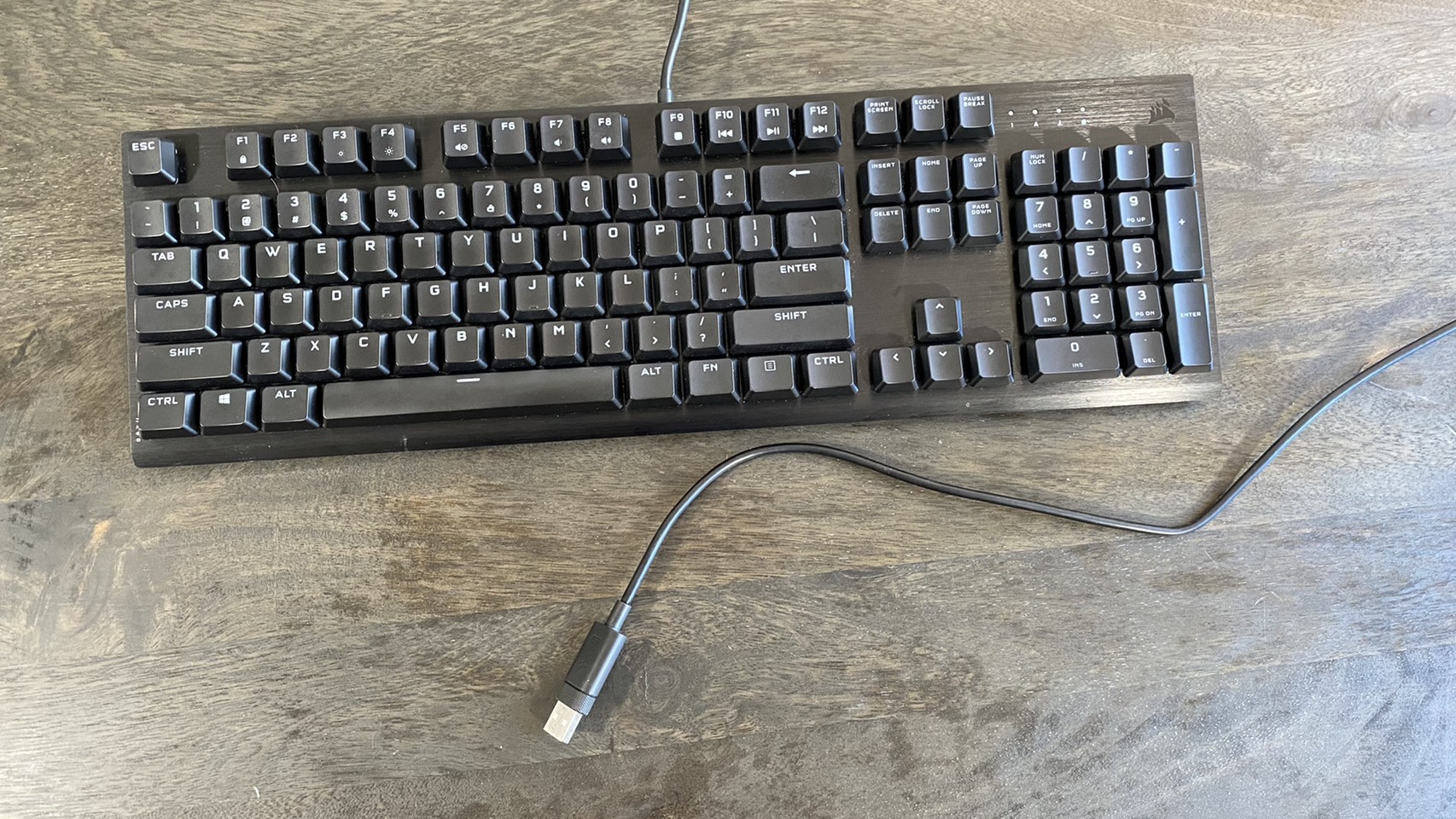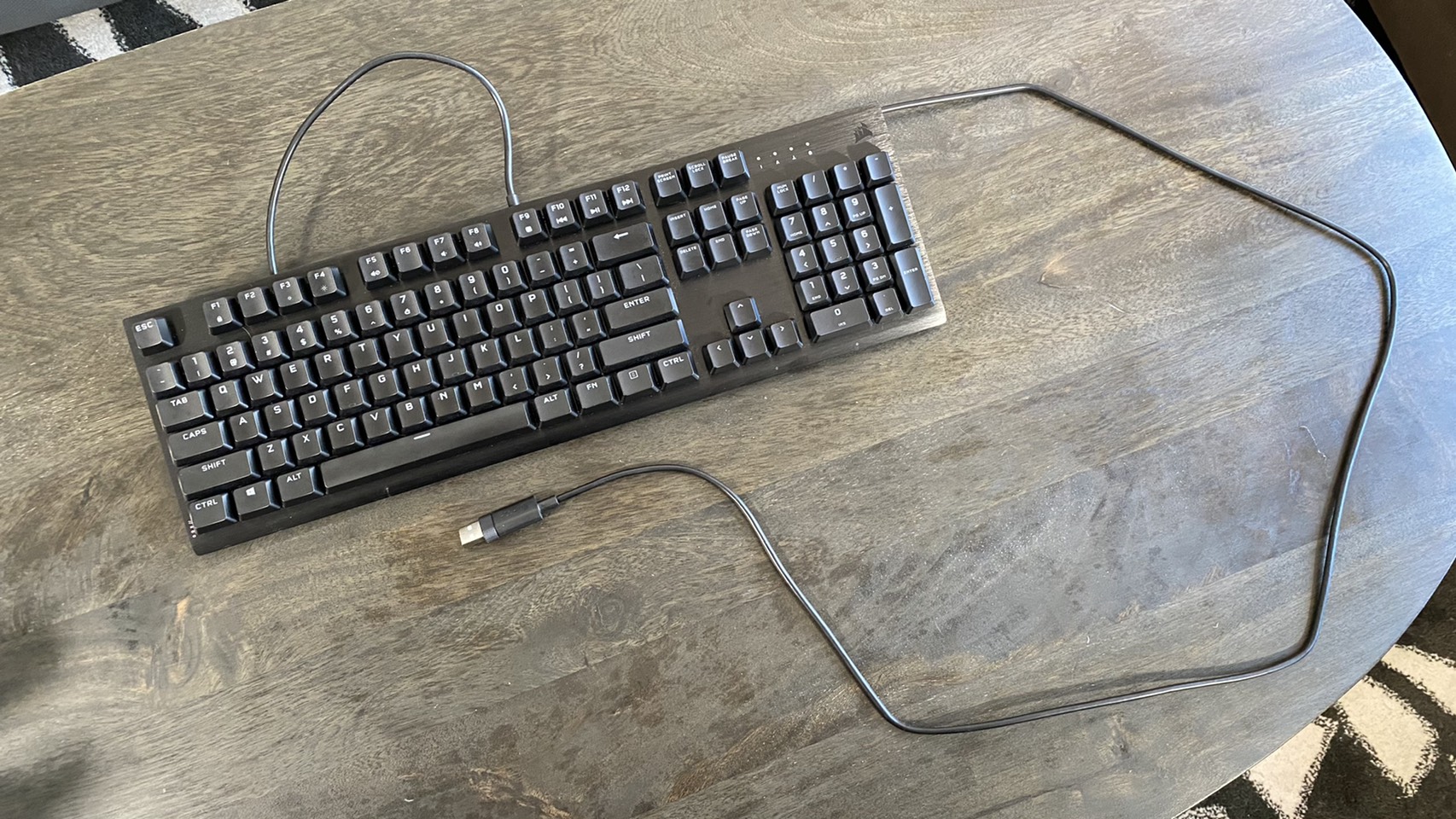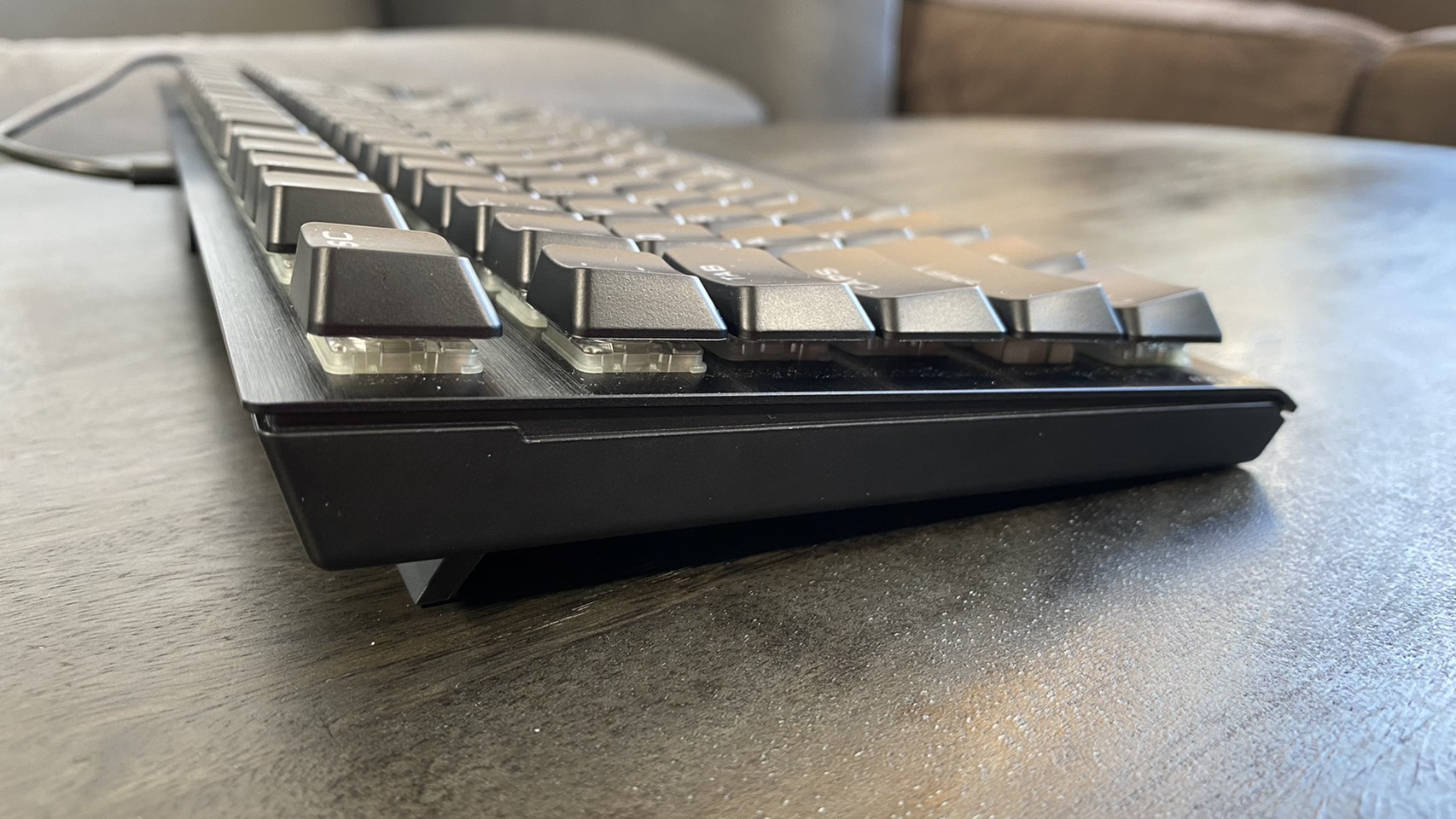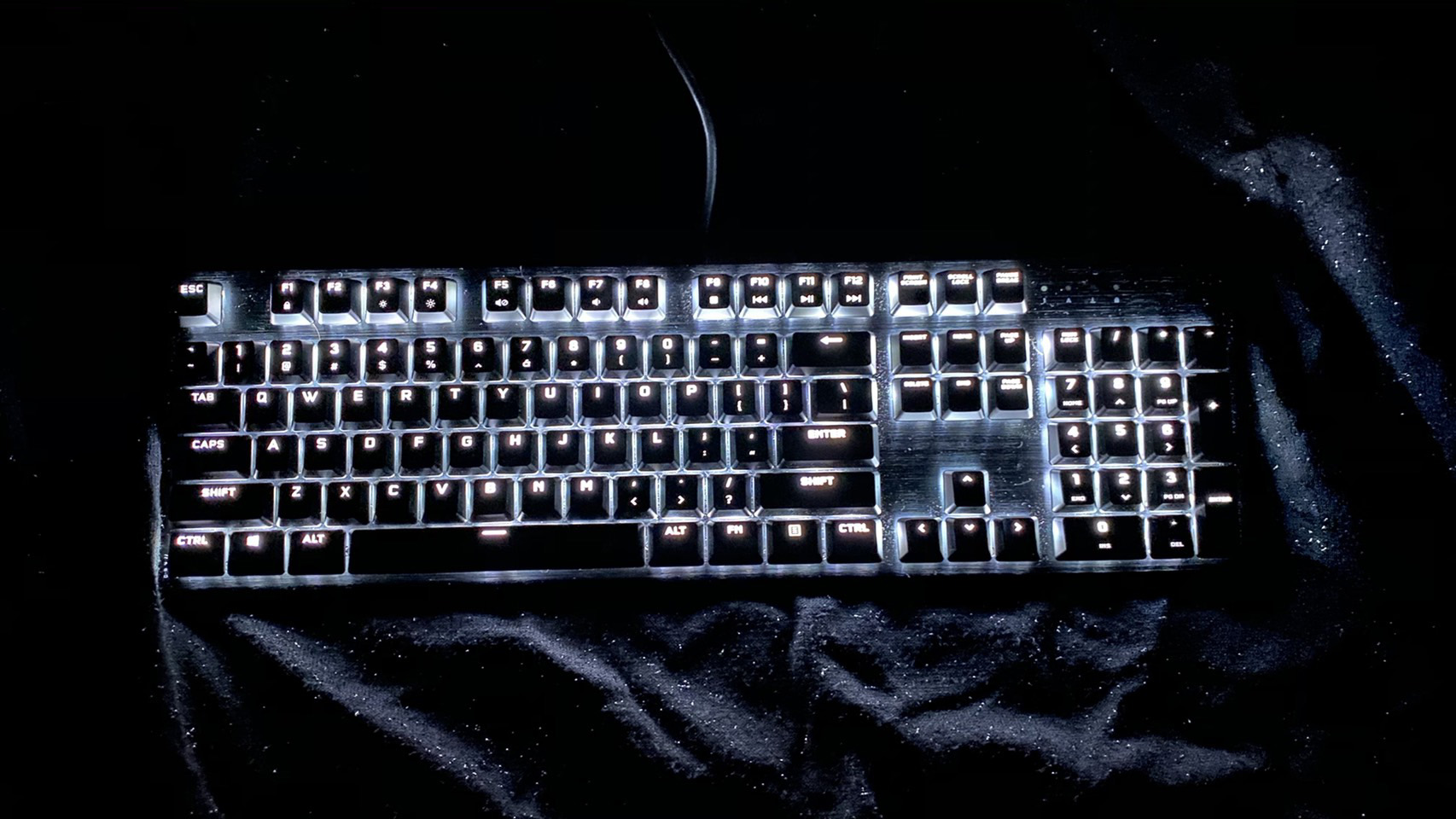Tom's Hardware Verdict
The Corsair K60 RGB Pro Low Profile is a reasonably priced quiet typer, but it’s feature-light, and its low profile input method isn’t for everyone.
Pros
- +
Cherry MX switches
- +
Comfortable
- +
Quiet
Cons
- -
No dedicated media buttons
- -
Cheap plastic construction in certain places
Why you can trust Tom's Hardware
Corsair is known for its flash and some of the best gaming keyboards around, but what happens when it aims for budget prices? Well, you get some stripped down features and cheaper switches, which is what we saw in the Corsair K60 RGB Pro. We were impressed by that keyboard’s $89.99 price but also found its budget Cherry Viola switches limiting. So now we’re taking a look at its more expensive cousin, the Corsair K60 RGB Pro Low Profile ($109.99).
This keyboard subs out the Cherry Viola switches from the regular RGB Pro with fancier Cherry MX RGB Low Profile Speed switches, which are constructed a little sturdier and require a little less force to press. They make the keyboard feel more premium but also mean adapting to a low profile typing style, which isn’t for everyone.
Given how similar the Corsair K60 RGB Pro Low Profile is otherwise to its non-low profile alternative, are those switches worth the additional $30?
Corsair K60 RGB Pro Low Profile Specs
| Switches | Cherry MX Low Profile RGB Speed |
| Lighting | Per-key RGB |
| Onboard Storage | RGB presets only |
| Media Keys | With Fn |
| Interface | USB 3.0 Type-A |
| Cable | 6 feet (1.8m), rubber |
| Additional Ports | None |
| Keycaps | ABS low profile |
| Construction | Aluminum top plate, plastic base |
| Software | Corsair iCue |
| Dimensions (LxWxH) | 17.4 x 5.4 x 1.2 inches (442 x 137.2 x 31.2mm) |
| Weight | 1.8 pounds (816.5g) |
Design on the Corsair K60 RGB Pro Low Profile




Visually and conceptually, the Corsair K60 RGB Pro Low Profile imitates the non low-profile version of the keyboard that we reviewed about a month ago. That’s not unexpected, given the name, but since the low profile version of the keyboard costs $30 more, it would be nice to see a few additional luxuries. There’s still no braided cable here, and unlike with the standard K60 RGB Pro, there’s not even an option to upgrade to a model with a wrist rest.
The keyboard’s base is the same lightweight plastic found throughout Corsair’s K60 series. Notably, the brush strokes on the black anodized aluminum top plate help make the keyboard appear a little more premium.
The subtlety of the branding also helps contribute to the premium look. The general Corsair logo only appears on the keyboard’s top right corner and easily blends into the top plate, thanks to being printed on glossy, black plastic. As for branding of the keyboard itself, all you’ll find is a vertical “// K 6 0” printed in small white text on the keyboard’s lower left corner.
This means you’ll be able to focus most of your attention on the keyboard’s features, which are fairly standard. You get an FN row with media controls and a Windows lock key towards the top of the keyboard.
Since this keyboard has a tenkey, it veers on the larger side, so be prepared to dedicate plenty of desk space to it. It’s 17.4 inches long and 5.4 inches wide, with an adjustable height that maxes out at 1.2 inches.That’s comparable to other keyboards with a low profile design. For example, the MSI Vigor GK50 Elite has similar dimensions (17.1 x 5.6 x 1.3 inches) and the Logitech G915 Lightspeed is longer and wider, but shorter (18.7 x 5.9 x 0.9 inches).
Typing Experience on the Corsair K60 RGB Pro Low Profile
As the name suggests, the big change here is the inclusion of Cherry’s MX Low Profile Speed switches. The other K60 keyboards have Cherry’s budget Viola switches. The Violas have a total travel distance of 4mm, while this keyboard’s MX Speed switches have 3.2 mm total travel. Both switches need 45 grams of force to actuate, but the Speeds also have a shorter 1 mm pre-travel, (as opposed to 2 mm on the Violas), making them more suitable for twitchy tasks like gaming, at least in theory.
There’s also construction differences between the two. The Viola switches on the non-low profile version of this keyboard are not soldered. Instead, they’re frame mounted and made from less expensive parts. The MX Speeds here are soldered and have a few more parts, and overall feel more sturdy. Both switches, however, are linear, meaning they lack any tactile bump or definitive click when you press.
I don’t typically use low profile keyboards, and initially, I disliked typing on the Corsair K60 RGB Pro Low Profile. The lack of travel distance made it feel like I wasn’t getting much physical feedback, and my input felt squishy when bottoming out. But after a few weeks of using this keyboard as my daily driver, my opinion started to change. This keyboard isn’t silent, but is quieter than non-linear and non-low profile alternatives, like the Razer Huntsman and Corsair Vengeance K65 I tend to use most frequently, thanks to its non-clicky switches and that cushiony bottoming out. This made it perfect for the home office I share with my boyfriend. And while keypresses still feel squishier when bottoming out than I’d like on a mechanical keyboard, I eventually found that cushiony feel made typing comfortable.
The K60 RGB Pro Low Profile’s keycaps are excellent. They’re made from ABS plastic that’s smooth and prone to smudges, but I’m willing to forgive that, thanks to the concave shape. These keycaps also have a slight downward curve toward the top that works with the concave shape to give my fingers a comfortable place to rest.
So, over time, the Corsair K60 RGB Pro Low Profile has grown on me for office work. It’s a great way for heavy typists to maintain finger strength throughout the day without bothering anyone working alongside you.
Get Tom's Hardware's best news and in-depth reviews, straight to your inbox.
But does that mean its numbers hold up? Kind of. When I first started using this keyboard, I tended to fall at 65- 70 words per minute (wpm) on the 10fastfingers.com typing speed benchmark, but now my speed is at 70-72 wpm. That means I’ve improved in just a few weeks but still have a way to go before I hit my typical 78-80 wpm. Typos are also still more frequent than I’m used to, but I attribute this more to my lack of experience with low profile switches than the keyboard itself.
My biggest typing issue was losing track of where I was on the keyboard. This was mostly due to the lack of physical feedback caused by the low travel distance. But because of how comfortable this keyboard feels during casual use, I’m willing to train up to be more attuned to how a low profile keyboard feels.
Gaming Experience on the Corsair K60 RGB Pro Low Profile
I’m still split when it comes to gaming with the Corsair K60 RGB Pro Low Profile. The Speed switches live up to their name, and keypresses take little force and feel as responsive as the Cherry MX Reds I’m used to gaming with. The low profile keycaps also help make travel time feel short, meaning there’s not much holding your fingers back from blazing input. Since the keycaps are comfortable, I could game for long hours without getting tired.
But the lack of physical feedback was also an issue. While losing track of my fingers when I type just slows me down, pressing the wrong key during a game can have serious consequences. For instance, I accidentally dodged in the wrong direction and into attacks more than a few times during my nightly Genshin Impact sessions, and my fingers occasionally felt cramped as I searched for the crouch button on first person shooters like Overwatch.
That said, input mistakes were less frequent than when typing, and that’s because I have pretty good muscle memory for where the WASD and shift keys are, among others. It’s just that the lack of travel distance occasionally threw me off and made me second guess myself. This put me in my head a little, leading to mistakes and hesitation.
If you’re already comfortable with low profile gaming, your experience will likely be more enjoyable. But for those newer to low profile switches, there will be an adjustment period. I saw the benefits of using low profile with typing, my gaming benefitted less clearly and quickly. I’d be willing to accept more travel distance and less comfortable keycaps in exchange for a little more physical feedback.
Features and Software on the Corsair K60 RGB Pro Low Profile

Despite finding its roots in a budget keyboard, the Corsair K60 RGB Pro Low Profile benefits from having access to Corsair’s robust iCue software. This is where you’ll make custom profiles, remap keys, record macros and set custom RGB effects. Unfortunately, there’s no onboard memory to store these profiles, so you’ll have to keep the software running to use them.
The keyboard’s only onboard memory is all taken up by RGB presets. And as mixed as I am on RGB (I’ve come around on it a bit since joining Tom’s Hardware) the stored effects are pretty cool. You can set the keyboard to emulate raindrops, display a visor effect a la RoboCop or even a spinning rainbow that cycles colors in a clockwise direction. There’s also one that lights up the whole keyboard in a rippling effect starting from your latest keypress, giving the Corsair K60 RGB Pro Low Profile some fun interactivity. If none of that suits you, you can also set per-key colors.
Macro recording is as simple as pressing record and inputting your keys. After, you can adjust things like mouse input and movement, as well as delay time and which actions trigger macros to begin or keep running. Additionally, you can check boxes that stop your computer from tracking certain functions during recording, like input delay.
The Corsair K60 RGB Pro Low Profile also has full n-key rollover, which is common on most gaming keyboards but still nice to see. I had difficulty even pressing enough keys at the same time to test this feature, but using an online tool, I easily registered over 50 simultaneous keypresses.
Bottom Line

The Corsair K60 RGB Pro Low Profile has more specialized and premium switches than the cheaper Corsair K60 RGB Pro but the two are otherwise identical. They have the same features and design, but with the Low Profile costing $30 more than the standard version, the deciding factor between the two will be whether or not low profile switches are worth the premium to you.
Despite “Speed” indicating that these switches are best used for twitchy tasks like gaming, I enjoyed this keyboard most for office work, thanks to its quiet sound profile and comfortable typing experience. The K60 RGB Pro Low Profile can game well, but low profile switches mean less travel distance, which will require adjusting for some. At $110, this keyboard is also pricey for its feature set.
For a full-sized version of this keyboard, the K60 RGB Pro has everything this one offers, except the low profile speed switches. If you want fancier switches and a low profile keyboard for a budget price point, consider the G.Skill KM360 with Cherry Reds.
Meanwhile, the MSI Vigor GK50 Low Profile is a good low profile alternative with Kailh White switches that costs about $25 less. That makes it a great choice for people who prefer clicky switches, which the K60 RGB Pro Low Profile lacks. Note that the Vigor GK50 also has 2mm shorter travel distance than the K60.
The Logitech G915 Lightspeed is another strong low profile alternative, with options for bespoke linear and clicky switches analogous to Cherry’s options, though its wireless and much pricier.
Which leaves the Corsair K60 RGB Pro Low Profile with a pretty comfortable niche in between budget and performance. If you want a typer with Cherry switches that can handle long typing sessions and moonlight in gaming, this keyboard is a more than reasonable ask at $110.
Michelle Ehrhardt is an editor at Tom's Hardware. She's been following tech since her family got a Gateway running Windows 95, and is now on her third custom-built system. Her work has been published in publications like Paste, The Atlantic, and Kill Screen, just to name a few. She also holds a master's degree in game design from NYU.
-
Findecanor I think that what makes it difficult to type on it is that it has "Speed" switches — which have lower actuation distance.Reply
Gamer-keyboard manufacturers somehow believe that lower actuation distance is a good thing for gaming, and thus they screw it up for those who'd want a keyboard mostly for typing.
I also think they could have been able to make it even lower.


